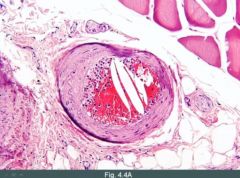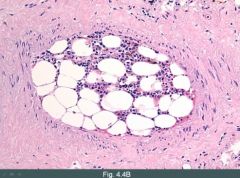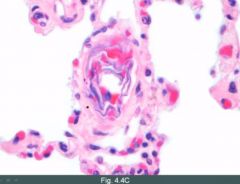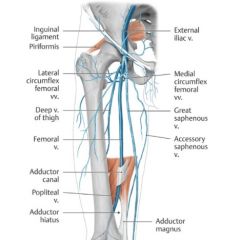![]()
![]()
![]()
Use LEFT and RIGHT arrow keys to navigate between flashcards;
Use UP and DOWN arrow keys to flip the card;
H to show hint;
A reads text to speech;
34 Cards in this Set
- Front
- Back
|
Define embolism.
|
Intravascular mass that travels and occludes downstream vessels. (En intravaskulær masse som vandrer og tilstopper/tetter igjen nedstrøms blodkar)
|
|
|
The MC source of an embolus is _____________.
|
a thrombus, called a thromboembolus (>95%)
|
|
|
What is a thromboembolus?
|
A thrombus that dislodges (slite løs)
|
|
|
What is an atherosclerotic embolus?
|
A piece of an atherosclerotic plaque breaks off and travels down the blood vessel and lodges somewhere else.
|
|

What is this? Where did it come from?
|
An embolus.
It's an atherosclerotic embolus due to the white cholesterol crystals in the middle ("cholesterol clefts") |
|
|
A fat embolus is classically seen with what?
|

Bone fractures. Particularly long bones. Also soft tissue trauma.
|
|
|
When does a bone embolus from a bone fracture occur?
|
It develops while the fracture is still present, or shortly after repair.
|
|
|
What clinical presentation would you see with fat embolus?
|
(1) Dyspnea (fat embolus to the lung)
(2) Petechiae on the skin overlying the chest |
|
|
_____ embolus is seen with decompression sickness (Dykkersyke, trykkfallssykdom). Explain how this happens.
|
The dive forces nitrogen to dissolve in the blood. When the diver rapidly ascends, the nitrogen can precipitate out of the blood creating small gas bubbles which can lodge in the tissues.
|
|
|
What are "the bends" and "the chokes"?
|
The bends - Muscle and joint paint in decompression sickness
The chokes - Respiratory symptoms |
|
|
What can decompression sickness present with?
|
Joint and muscle pain, and respiratory symptoms
|
|
|
What is Caissons disease?
|
Chronic form of decompression sickness.
It is characterized by multifocal ischemic necrosis of the bone. |
|
|
In what surgic procedure might we see gas embolus formation?
|
Laparoscopic surgery. In this procedure we pump air into the abdomen.
|
|
|
What type of embolus may form during labor?
|
Amniotic fluid embolism. Occurs during labor or delivery.
|
|
|
A woman during labor is having shortness of breath and neurologic symptoms. What might be going on? Explain.
|
Amniotic fluid embolus. Presents with dyspnea, neurologic symptoms and DIC.
|
|
|
Why could a woman with amniotic fluid embolus get DIC?
|
Amniotic fluid is loaded with tissue thromboplastin
|
|
|
When you're looking at the emboli of a patient with an amniotic fluid embolus in the lungs (for example), what do you see in the microscope?
|

Squamous cells and keratin debris from fetal skin (the babys' skin was sloughing off over time in the amniotic fluid)
|
|
|
PE is usually due to a _______________ that arises due to a _____.
|
thromboembolus; DVT
|
|
|
In PE, the embolus usually comes from a DVT in the lower extremity, usually involving what?
|

(1) Femoral veins
(2) Iliac veins (3) Popliteal veins |
|
|
Most often, PE is clinically ____________ (silent/devastating).
|
silent
|
|
|
Why is a PE often clinically silent?
|
(1) The lung has a dual blood supply.
- Bronchial a. from aorta to lung - Pulmonary a. going into the lung (2) Embolus is usually small and self-resolves. |
|
|
Pulmonary infarction due to embolus require a couple of things to happen due to the dual blood supply of the lungs. List them.
|
(1) Obstruction of large- and medium-sized.
(2) The patient needs to have a pre-existing cardiopulmonary compromise. |
|
|
____% of PE's cause infarction.
|
About 10%
|
|
|
What are clinical features of PE?
|
(1) Shortness of breath
(2) Hemoptysis (3) Pleuritic chest pain (4) Pleural effusion |
|
|
A type of CT that may be used in PE. What would it show?
|
Spiral CT shows a vascular filling defect in the lung.
|
|
|
A V/Q scan in PE would show __________.
|
mismatch
|
|
|
How could you identify that a DVT is present in the lower extremities of a patient with PE?
|
Doppler ultrasound.
|
|
|
What hematologic lab may be elevated in PE?
|
D-dimer
|
|
|
The gross exam of a pulmonary infarction shows a _________-shaped, __________ infarct.
|
Wedge-shaped (dichotomous branching) hemorrhagic infarct. It's hemorrhagic because the second blood supply is bringing blood into the dead tissue, and the tissue is loose.
|
|
|
Sudden death in cases of saddle emboli are due to _____________.
|
electromechanical dissociation... the heart is pumping but the blood supply is totally blocked, so the patient undergoes sudden death.
|
|
|
What may happen with a patient that has small emboli lodging in the lungs over time?
|
Chronic emboli that are reorganized over time result in pulmonary HTN.
|
|
|
When an embolus lodges in the systemic circuit, where does it most commonly arise from? What is it usually due to?
|
(1) MC arise in left heart
(2) Usually due to thromboembolus |
|
|
An embolus that travels down systemic circulation from the left heart is MC to occlude flow to _______________.
|
lower extremities
|
|
|
What is another substance that can damage the endothelium producing vessel thrombosis?
|
Antiphospholipid antibodies (lupus anticoagulant anticardiolipin antibodies).
|

